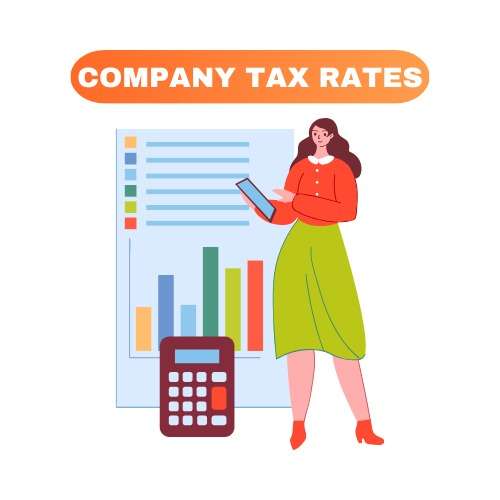Dive into the vibrant world of Australia’s bustling business scene, and you’ll find a key player shaping its contours: company tax rates. Australia, a vast land of opportunities, has become a focal point for businesses globally, not just because of its rich resources or innovative spirit but also due to its evolving tax landscape. Company tax rates in the “Land Down Under” are not just mere numbers on paper; they form the backbone of many strategic decisions that fuel business growth. Whether you’re an entrepreneur eager to dip your toes in the Australian market or an existing business aiming to maximize profitability, understanding the nuances of Australia’s company tax rates is pivotal. This knowledge not only ensures compliance but also offers valuable insights for harnessing the full potential of the nation’s vibrant economic environment for robust business growth.
Current Company Tax Rates in Australia
The Australian taxation landscape for companies in the fiscal year 2022–23 offers a diverse set of rates based on the nature and classification of entities. Here’s an analytical overview:
1. General Companies:
- Base Rate Entities: Such entities are taxed at a rate of 25%. Companies with annual sales below certain levels, corporate limited partnerships, strata title bodies corporate, trustees of corporate unit trusts, and public trading trusts are mostly in this group.
- Standard Corporate Entities: Entities not fitting into the base rate classification fall here, facing a tax rate of 30%.
2. Life Insurance Companies:
- Ordinary Class: A tax rate of 30% is applicable.
- Complying Superannuation Class: This segment gets a reduced tax rate of 15%.
- Additional Tax on No-TFN Contributions: Specifically for RSA providers, an additional tax of 32% is levied on certain contributions.
3. Retirement Savings Account (RSA) Providers:
- RSA Component: They are charged at 15%.
- Additional Tax on No-TFN Contributions: A tax rate of 32% applies here.
- Standard Component: For base-rate entities, it’s 25%, while others get charged 30%.
4. Pooled Development Funds:
- Small and Medium Enterprises Component: This segment enjoys a 15% tax rate.
- Unregulated Investment Component: Taxed at 25%
- Excess Amount: If an amount surpasses the PDF component, base rate entities face a tax rate of 25%, while others are taxed at 30%.
5. Credit Unions:
- Small Credit Unions: Taxation varies based on whether they’re base-rate entities (25%) or otherwise (30%). They also have special provisions for mutual interestss.
- Medium Credit Unions: Taxation ranges from 37.5% (base rate entities) to 45% (otherwise), based on their income bracket.
- Large Credit Unions: Whether they are base-rate entities or not, they face tax rates of 25% or 30%, respectively.
6. Not-for-profit Companies:
- Companies with a taxable income between $0-$416 are not taxed.
- Those with a taxable income between $417-$915 face a high tax rate of 55%, but only on the amount exceeding $416.
- Entities with a taxable income above $915 are taxed at 30% of their complete income.
7. Not-for-profit Companies (Base Rate Entities):
- Companies earning between $0-$416 aren’t subjected to tax.
- Those earning between $417-$762 are taxed at 55% on the amount over $416.
- If the income surpasses $762, a rate of 25% is applied.
The tax system is meticulously structured to cater to various kinds of businesses and their unique needs. It’s essential for companies to understand their classification and the associated tax rates to ensure compliance and make informed financial decisions.
Historical Overview of Company Tax Rates in Australia
How the rates have evolved:
In the latter half of the 20th century, Australia’s company tax rates underwent notable fluctuations. Initially positioned as one of the countries with relatively high corporate taxation, Australia has, over the years, taken steps to adapt to the global economic environment. The objective has often been to stimulate economic activity, attract investments, and bolster the domestic market.
Also Read: Company Tax Return Instructions 2023
Recent significant changes:
The past decade has witnessed several reforms in the Australian tax system. The emphasis has shifted towards making the country more amiable for businesses, both local and foreign. There’s been a notable reduction in company tax rates, with the goal of making Australia competitive in the global market, particularly against its primary economic partners in the Asia-Pacific region. Here are the company tax rate changes.
How Company Tax Rates Impact Business Growth
1. The direct implications for corporations:
Company tax rates have a direct bearing on the net profitability of corporations. A higher tax rate might diminish the after-tax profit of a company, affecting its ability to reinvest or expand. On the contrary, competitive company tax rates can enhance post-tax returns, giving corporations a more significant margin to channel back into their operations, leading to growth and expansion.
2. Global competitiveness and attractiveness:
In the age of globalization, company tax rates also determine how appealing a country is for foreign direct investments. Competitive tax structures can draw multinational corporations looking for optimal locations to establish or expand their operations. As such, Australia’s company tax rates play a pivotal role in positioning the nation on the global economic map and influencing the decisions of global enterprises.
Strategies to Navigate the Australian Tax System
Maximizing deductions and incentives:
For businesses operating in Australia, understanding the nuances of the tax system is crucial. It’s not just about the headline company tax rates; it’s also about the various deductions and incentives available. By effectively leveraging these, businesses can significantly reduce their effective tax liability, thereby boosting their bottom line.
Understanding the tax breaks:
Apart from standard deductions, the Australian government also offers specific tax breaks for certain sectors and activities. For instance, companies investing heavily in research and development might be eligible for additional tax incentives. By staying informed and understanding these tax breaks, companies can further optimize their financial strategies and grow in the competitive Australian market.
The Future Forecast: What Businesses Can Expect

As the global economic landscape evolves, Australia’s company tax rates are expected to undergo further adjustments to remain competitive. We designed this continuous adaptation to cater to the changing dynamics of international business. Economic experts predict that the Australian government may introduce more incentives to attract foreign investments, given the crucial role that company tax rates play in this decision-making process. Businesses can anticipate a more streamlined tax structure, with possible reductions or more comprehensive tax breaks to promote business growth and innovation in the country.
Key Takeaways: Harnessing Australia’s Tax System for Business Prosperity
- Understanding the Landscape: Grasping Australia’s company tax rates is the first step towards business prosperity. By staying informed and updated on the shifts and nuances of the system, businesses can plan strategically, ensuring they’re always ahead of the curve and maximizing profitability.
- Global Competitive Edge: Australia’s company tax rates, when viewed in a global context, provide a competitive edge to businesses. A favorable rate not only attracts foreign investments but also provides local businesses with a platform to venture internationally, harnessing global opportunities.
- Tailored Strategies: Each industry and business size might face unique tax implications. By tailoring strategies around specific company tax rates and incentives, businesses can exploit opportunities and minimize liabilities.
- Regional Nuances Matter: The vastness of Australia means that different regions might offer varied incentives or slightly distinct approaches to company tax rates. Being aware of these regional nuances can be a game-changer for businesses looking to optimize their tax position.
- Future Forecasting: The realm of company tax rates is dynamic. Businesses that keep an eye on potential future shifts and adjust their strategies accordingly stand to gain immensely, ensuring sustained growth and prosperity in the ever-evolving Australian business landscape.
Conclusion:
In navigating the intricate landscape of Australia’s company tax rates, businesses find both challenges and unparalleled opportunities. By staying informed, tailoring strategies, and adapting to regional nuances, they can harness the full potential of the Australian tax system for their growth and prosperity. As the dynamic world of taxation continues to evolve, companies that remain proactive and engaged will undoubtedly lead the pack. But beyond all strategies and numbers, the real essence lies in understanding and leveraging these insights for tangible business outcomes. What do you believe is the next big change in Australia’s company tax structure, and how are you preparing for it?
FAQs
1. How has Australia’s company tax rate changed over the years?
Over the years, Australia has worked towards reducing its company tax rates, making it more competitive globally.
2. Why are tax rates crucial for business growth?
Tax rates directly affect post-tax profits, investments, and overall business strategies, influencing growth trajectories.
3. What strategies can businesses employ to benefit from Australia’s tax system?
Companies should stay informed about available deductions, incentives, and regional tax variations to maximize benefits.
4. Where does Australia’s tax rate stand globally?
Australia offers a competitive tax rate, especially when combined with its stable governance and robust economy.
5. Are there any specific industries that receive added tax benefits in Australia?
Yes, sectors like R&D and some primary industries often receive added incentives and tax breaks.




